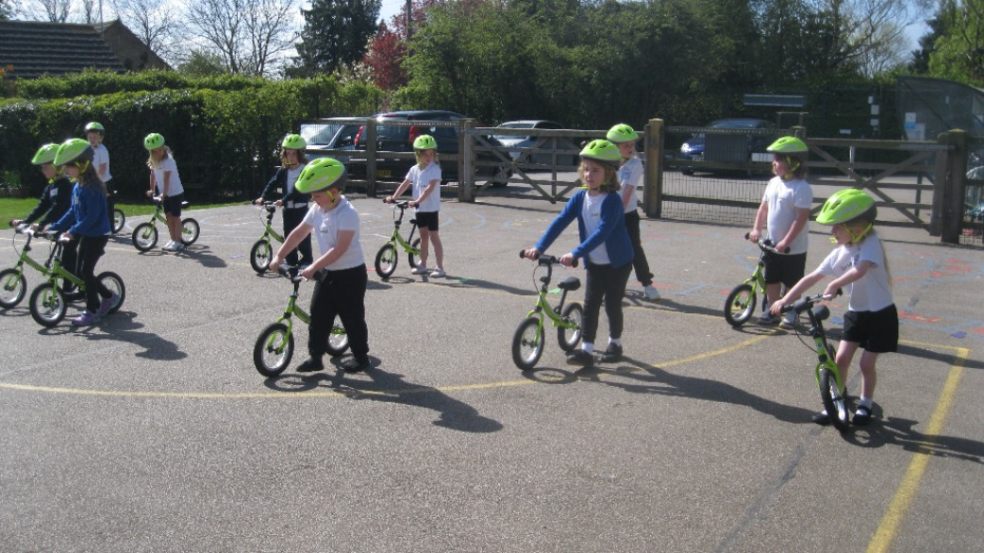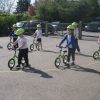
Balanceability supports Cycle to School Week 2024 with top tips for helping children set off on two wheels
Teaching a child to ride a bike can be daunting and frustrating for all concerned, but Balanceability is helping parents and carers get their little ones moving on two wheels, in support of Cycle to School Week, 23rd-27th September 2024. By downloading Balanceability’s Parent Guide and following its top tips for learning to ride two-wheels, stress can be replaced with fun and children can set off to school or nursery with c onfidence.
A recent survey of bike-riders* by Balanceability revealed that most people learnt to cycle with help from their dad (55%), while 13% were self-taught, 11% taught by their mum and just 2% of cyclists learnt to ride at school. One in five cyclists surveyed said they learnt to ride a bike before school age, with the majority (61%) confirming they learnt to ride when they were primary school age.
Balanceability offers a sustainable programme for schools to promote the physical benefits of cycling for children as young as 2½ years old, as well as providing a fun and engaging activity, but it believes that parents and carers can also play an important role in getting children cycling. Samantha Wright, Commercial Manager for Balanceability, part of the TTC Group a pioneer on road safety education advises, “We recommend taking the first step to cycling on a balance bike, as it helps children learn and gain confidence on a bike more quickly. Whilst using stabilisers does work, children can become reliant preventing them from developing balance skills. Once stabilisers are taken off the child needs to learn how to balance and steer all over again which can also affect their confidence on a bike.
“On a balance bike, children learn to balance naturally, more quickly than when reliant on stabilisers, setting them up for a smooth and easy transition to pedal bikes when they’re older. Cycling is fun, it's good exercise and when children cycle to school and nursery instead of being driven it reduces air pollution and brings environmental benefit. By following our tips, it will help children transition from a balance bike to a pedal bike successfully.”
The Department of Transport’s Bikeability Level 1 is for children 6+ years, with other Government cycle programmes aimed at children 10-11-years-old, so Balanceability fits as the precursor. The UK’s only afPE-approved learn-to-cycle programme, Balanceability offers packages for schools, local authorities and leisure sites for children aged 2½ years and upwards. The programme teaches children how to ride without stabilisers, giving them important gross motor skills, core stability and plenty of fun through physical activity.
Balanceability Top Tips for helping children set off on two wheels
- Get to know the bike – Simply sitting on the stationary bike is an important first step for young children, getting them comfortable with the bike and giving them the all-importance confidence to get started on their cycling adventure.
- Pick your path – A smooth, relatively flat traffic free space is perfect for practicing on a balance bike – Avoid steep slopes when they are starting out.
- Utilise all opportunities – If you are going for a short walk, you could let your child bring their bike along with you on the path. Most balance bikes are small and light enough to carry if they run out of cycling steam before you get back home.
- Boost balance – Learning to balance doesn’t all have to involve the balance bike. When you’re out and about in a safe environment such as a playground, encourage your child to jump, hop, climb, balance safely on low objects and walk along narrow lines like a tightrope.
- Take it slow – Trying to rush or push a child learning to balance on their new bike will only end in tears – not necessarily the child’s. Pressure will cause frustration and slow their progress.
- Be child-led – Let your child set the pace. They may need to walk while standing over the bike for a while before they are able to sit and walk, this is an important stage of learning to ride so don’t rush them to sit.
- Praise progress – Help to boost their confidence by praising their efforts and any progress – however small, and even if you’re finding it a frustratingly slow process!
- Know when to move on – Once your child is confidently zooming around obstacles and lifting their feet off the ground while they go, it may be time to try learning to pedal. You will need to ensure the new bike is the right size and the seat is set to the correct height, or it will be too difficult and knock the new cyclist’s confidence.
- Ask the pros – Many schools and Early Years settings run Balanceability balance bike training courses for children as young as 2 ½, even providing the bikes on which they learn. Children enjoy learning with their teacher and their friends and pick up the skills quickly.
Schools can purchase a Balanceability Pack which includes all the equipment, resources and training required to deliver the sessions as a sustainable programme. Balanceability can be run by teachers indoors or outdoors as part of the weekly regular PE activity and has been developed to fit into school lesson planning. The programme offers children the ability to become competent cyclists at an early age through the development of balance and control, with 94% of children aged 4 to years 6 years old able to safely ride a pedal bike at the end of the programme.














